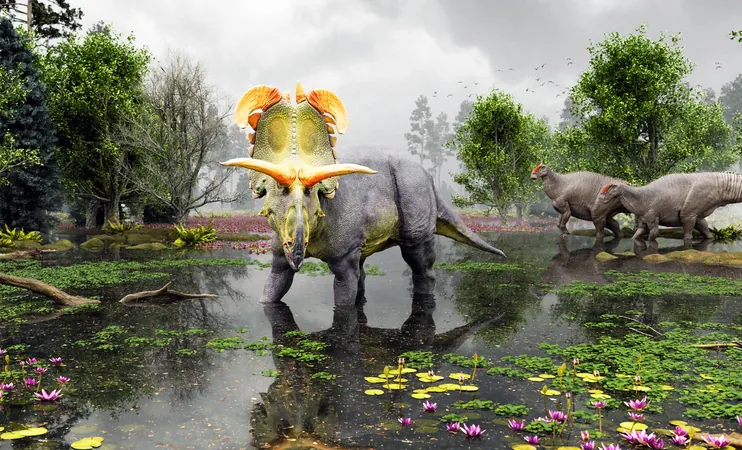
Meet Lokiceratops: The Largest Horned Dinosaur That Looks Like It Leapt Out of a Comic Book
2025-05-31
Author: Yu
A Stunning Discovery in Dinosaur Evolution
Prepare to be amazed! Scientists have unveiled a remarkable new species of horned dinosaur, Lokiceratops rangiformis, which is stirring excitement in the paleontological world due to its gigantic size and elaborate frills. A recent study published in PeerJ reveals that this colossal creature not only holds the title for the largest and most intricately adorned dinosaur of its kind ever found, but it also reshapes our understanding of ceratopsian diversity and behavior.
From Montana to Mythology: The Origins of Lokiceratops
Unearthed from the depths of northern Montana, close to the U.S.-Canada border, the partial skull of Lokiceratops left researchers Mark Loewen and Joseph Sertich utterly astonished. Despite its incomplete state, the fossil revealed striking features, including dramatic, blade-like horns and an ornate frill, unlike anything seen in its dinosaur relatives. Loewen shares, “The dinosaur now resides in Denmark, so we honored Norse mythology by naming it after Loki, the trickster god, whose horns inspired our choice.” The species name 'rangiformis' reflects its caribou-like appearance.
Revealing the Secrets of Cretaceous Communication
Beyond its incredible size, Lokiceratops showcases how skull ornamentation can unlock secrets about dinosaur behavior. Its unique asymmetrical brow horns and lack of a nose horn set it apart from others. Researchers believe these features were not for combat; instead, they likely served social and visual purposes in a prehistoric context. Sertich notes, “These ornaments might have evolved similarly to how peacocks display their feathers, influencing mate choice and species recognition.” In crowded ecosystems, such visual signals were essential for maintaining reproductive boundaries.
Five Horned Giants: A Cretaceous Surprise
The real jaw-dropper? Lokiceratops was just one of five different ceratopsian species cohabiting the same small area at the same time, all found in the fossil-rich Kennedy Coulee Assemblage. Sertich highlights the unprecedented diversity: “This discovery is akin to observing various horned ungulates roaming the African plains today.” This challenges previous beliefs that large herbivores preferred dispersal, suggesting instead that they thrived in localized environments, evolving unique traits to coexist.
An Evolutionary Hotspot: A Window into the Past
This finding illuminates how geographical isolation and environmental variations fueled the evolution of horned dinosaurs. Unlike modern-day herbivores, Lokiceratops and its kin likely remained in restricted habitats, adapting rapidly to shifts in their surroundings. Loewen emphasizes, “Lokiceratops reveals that we are just beginning to grasp the incredible diversity and lineage of horned dinosaurs.” This insight repositions Laramidia, the ancient expanse where they roamed, as a vibrant hub of ceratopsian evolution, leading to stunning horn displays as vibrant as today’s avian plumage.
A New Chapter in Paleontology Awaits
With this groundbreaking study updating the ceratopsian family tree, researchers believe there are likely many more undiscovered species lying in untapped fossil beds. Just like Darwin's finches in the Galápagos Islands, each isolated group of ceratopsians seems to have developed its own distinctive identity and visual flair. Lokiceratops is not just a new dinosaur; it’s a ticket to unraveling the mysteries of prehistoric life!


 Brasil (PT)
Brasil (PT)
 Canada (EN)
Canada (EN)
 Chile (ES)
Chile (ES)
 Česko (CS)
Česko (CS)
 대한민국 (KO)
대한민국 (KO)
 España (ES)
España (ES)
 France (FR)
France (FR)
 Hong Kong (EN)
Hong Kong (EN)
 Italia (IT)
Italia (IT)
 日本 (JA)
日本 (JA)
 Magyarország (HU)
Magyarország (HU)
 Norge (NO)
Norge (NO)
 Polska (PL)
Polska (PL)
 Schweiz (DE)
Schweiz (DE)
 Singapore (EN)
Singapore (EN)
 Sverige (SV)
Sverige (SV)
 Suomi (FI)
Suomi (FI)
 Türkiye (TR)
Türkiye (TR)
 الإمارات العربية المتحدة (AR)
الإمارات العربية المتحدة (AR)